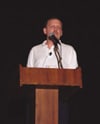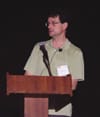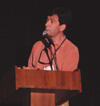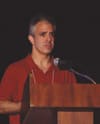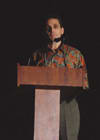Retinal
Physician Symposium Provides Forum for Specialists
New
data on pharmacologic and surgical therapies spark conversation on the best
methods of managing retinal pathologies in practice.
BY RACHEL RENSHAW, EXECUTIVE
EDITOR • JACQUELINE ZUMMO, MEDICAL EDITOR
|
DISCUSSION LEADERS |
|||||||||||||||||||||||||||||||||||||
|
|||||||||||||||||||||||||||||||||||||
The first annual Retinal Physician Symposium (RPS) was held May 19-22, 2005 at the Atlantis Resort on Paradise Islands, Bahamas. More than 80 retinal specialists attended the meeting, which was spread over 3 days and featured symposia, a welcome cocktail reception and exhibitor's reception, and a golf tournament.
Physicians who attended were given the opportunity to learn from their colleagues and interact in an intimate, unique open-forum setting, which permitted interaction among the attendees in a free and approachable fashion. The symposium included lively discussions among attendees that addressed the controversial aspects of each presentation, including the on- and off-label use of age-related macular degeneration (AMD) treatments. Each presenter took questions after their presentations, which gave attendees an opportunity to challenge and question the information presented, as well as have any materials clarified that they felt were unclear. Jason Slakter, MD, and Rick Spaide, MD, led the discussions.
BLUE-BLOCKING IOLS
The symposia began with a presentation on blue-blocking IOLs, in which Martin A. Mainster, MD, FRCOphth, PhD, addressed the issue of whether the advantages of lenses that block UV light outweigh the increased visual acuity (VA) that blue light offers aging patients in mesopic and scotopic conditions. Dr. Mainster concluded in his presentation that because there is no clinical or experimental proof that normal light exposure causes AMD, it is more important to give aging patients the maximum amount of blue light for increased VA rather than provide protection from retinal photoxicity that may be, in effect, inconsequential.
ANTIANGIOGENIC THERAPY FOR AMD
Not surprisingly, many of the presentation during RPS revolved around anti-vascular endothelial growth factor (VEGF) therapy. With the approval of pegaptinib sodium (Macugen, Eyetech/Pfizer) and the impending approval of ranibizumab (Lucentis, Genentech) and anecortave acetate (Retaane, Alcon Laboratories, Inc.), these data were of great interest to attendees and spurred a good amount of questions and debate.
Christine R. Gonzales, MD, provided attendees with an overview of the latest data on pegaptinib sodium injections for anti-VEGF therapy. In her presentation, Dr. Gonzales discussed the role of VEGF in pathologic ocular choroidal neovascularization (CNV) and AMD, as well as the use of pegaptinib sodium to block pathologic VEGF. Dr. Gonzales outlined the design and results of the VEGF Inhibition Study in Ocular Neovascularization (VISION), which showed pegaptinib sodium injections to be safe, tolerable, and effective in preserving vision over a 2-year period regardless of angiographic subtype, lesion size, or baseline VA.
In her second presentation, Dr. Gonzales discussed pegaptanib sodium following the Food and Drug Administration (FDA) approval, including case selection, imaging studies, patient expectations and informed consent, the importance of early treatment and continued therapy, and its potential role in combination therapy.
Ranibizumab for anti-VEGF therapy is currently still undergoing FDA phase 3 trials. Philip J. Rosenfeld, MD, PhD, reviewed the phase 1 and 2 data and discussed the phase 3 studies that are currently underway. Thus far, the FDA study results have been promising for this new injection therapy for AMD, which is expected to receive final approval by late 2006 or early 2007.
Dr. Slakter presented data on anecortave acetate, which addresses AMD via multiple mechanisms of action. The preliminary results of the phase 2 and 3 study to evaluate the 24-month dose response with monotherapy for 3 doses (3 mg, 15 mg, and 30 mg) vs. placebo has found that anecortave acetate reduces vision loss compared with placebo, and is effective in inhibiting the growth of CNV lesions.
In addition to providing a photodynamic therapy (PDT) patient management update, Peter K. Kaiser, MD, presented on the development of small interfering RNAs (siRNAs) as ocular therapeutics. Basically, siRNAs are short molecules that seek out targets, specifically VEGF in the case of AMD, that trigger disease.
IMPROVEMENTS ON AVAILABLE THERAPIES
Dr. Mainster again took the podium to discuss how using micropulsing with transpupillary thermotherapy (TTT) can significantly reduce the amount of chorioretinal damage and how lower lite-dose applications can be used in PDT. Dr. Mainster explained how repetitive micropulsing delivers the energy in short bursts, thus minimizing heat build-up and conduction to the neural retina or collateral sites.
Richard Spaide, MD, presented information to support why combination therapies may be useful in AMD. He referred to the 2-component model that is often used in cancer treatment and related its usefulness for approaching AMD. Dr. Spaide also discussed retinal vascular treatments. He explored the benefits of this type of treatment, including the decrease in vascular diameter, number, and permeability; the decrease in tissue hydrostatic pressure; and the possibility that it can improve circulation.
While laser photocoagulation continues to be the most widely accepted therapy for classic CNV secondary to AMD, retinal specialists generally agree that there is no good treatment for subfoveal CNV. However, as Henry Hudson, MD, outlined in his presentation "High-speed Feeder Vessel Therapy," photocoagulation of feeder vessels may stabilize or improve VA for patients with subfoveal CNV. Dr. Hudson reviewed the studies that have been performed with feeder vessels and evaluated the techniques that were used.
To finish the morning presentations, Micheal T. Trese, MD, broached the topic of stem cell therapy for retinal disease. According to Dr. Trese evidence exists to suggest that stem cells may be able to be used to treat progressive retinal cell loss in atrophic AMD, retinitis pigmentosa, pattern dystrophy, neovascular AMD, familial exudative vitreoretinopathy, retinopathy of prematurity (ROP), and Coats' disease. By utilizing the stem cells' potential ability to incorporate themselves and function, transplants may be able to rebuild subretinal space after treatment with anti-VEGF therapy.
Dr. Trese also presented the results of a study on the 10-year incidence of blindness from ROP, which also incorporated the results of consistent screening and treatment for ROP. According to Dr. Trese, timely screening and laser or surgical intervention can result in a low incidence of blindness in these patients.
PHARMACOLOGY AND IMAGING TECHNOLOGIES FOR AMD
Dr. Slakter began Friday afternoon sessions with a presentation on the pharmacologic approach to preventing CNV, addressing the importance of prevention, safety and tolerability, the limitations that exist with current therapy, and the future therapies to treat and prevent vision loss. Laser therapy, nutrition, and antiangiogenic therapy all currently target the control of AMD in terms of vision stabilization to limit acuity loss. However, most patients with CNV have lost a significant amount of VA. Dr. Slakter highlighted the success of AREDs for preventing CNV, as well as the early success of anecortave acetate in clinical trials to stabilize and improve VA after CNV.
Jay S. Duker, MD, discussed in detail ultrafast, ultrahigh resolution optical coherence tomography (OCT), which is an improvement of 3 generations of OCT. The current version of OCT, the Stratus OCT3 (Carl Zeiss Meditec, Inc), which became commercially available in 2002, has a resolution of 8 μm–10 μm, but is still unable to perform true optical biopsy, according to Dr. Duker. Thus, a newer technology has been developed in high resolution OCT, which allows for resolution of 2 μm–3 μm and fast 3D imaging. This technology uses a mode-locked, titanium sapphire laser light source that offers higher spectral bandwidths to allow for better imaging for macular hole, idiopathic telangietasia, AMD, retinitis pigmentosa and macular dystrophies, and "microscotoma" cases.
Thomas R. Friberg, MD, MS, continued the discussion on imaging technologies with his presentation "Wide-Angle and Non-Mydriatic Retinal Imaging and Angiographic Systems." Among several nonmydriatic retinal-imaging systems that were included, all of the systems fall short in terms of lack of stereo imaging and low resolution. Dr. Friberg reported on the 200°-plus wide-angle imaging system (Panoramic 200) from Optos (Marlborough, MA) and the nonmydriatic angiography component that is currently in development. The device is able to provide high-resolution images to aid in accurate diagnoses. Wide-angle angiography is produced by adding a blue-laser (488 nm) to the scanning array, while the existing green channel detector images the fluorescence, according to Dr. Friberg. The capabilities of panoramic angiography include the evaluation of areas of peripheral ischemia, identification of peripheral neovascularization, the ability to follow proliferative diabetic retinopathy, identification of retinal angiomas, and evaluation of treatment efficacy.
REIMBURSEMENT ISSUES
Friday's sessions concluded with presentations by George Williams, MD, and Riva Lee Asbell, who own a coding consultation company which focuses on reimbursement and coding issues. Dr. Williams gave a history of physician reimbursement, beginning with the inception of Medicare in 1964. According to Dr. Williams, the primary issue in physicians reimbursement is "the adverse effect of the sustainable growth rate," and that "the formula for calculating the sustainable growth rate is based on unrealistic and invalid assumptions, which penalize physicians for factors that are beyond their control." Also at issue is how surgical and laser codes are reviewed. The surgeon may, in the end, be penalized for implementing procedures that shorten surgical time and increase efficiency.
Asbell's presentation followed with an update of the codes that should be used in vitreoretinal surgical procedures, including modifier challenges and CPT codes for new technology.
NEW TREATMENTS AND TECHNOLOGIES
Photodynamic therapy and intravitreal triamcinolone were the topics of Dr. Spaide's first presentation on Saturday. Combination therapy can provide effective results for AMD cases that are nonresponsive to monotherapy. Combination therapy has also been used successfully in patients with cancer. According to Dr. Spaide, patients who are treated with combined PDT and triamcinolone have better results than patients treated with only PDT. The rationale for this combination, as well as case reports that show efficacy were presented to attendees.
Abdhish Bhavsar, MD, presented data on the hyaluronidase (Vitrase, ISTA Pharmaceuticals) for injection for the treatment of vitreous hemorrhage. The mechanism of action for hyaluronidase is such that it cleaves glycodisic bonds of hyaluronan, leads to the collapse and liquefaction of vitreous, thereby facilitating diffusion of molecules, including pro-inflammatory chemotactic factors and promoting ingress of phagocytic cells and egress of red blood cells and proteins, said Dr. Bhavsar. phase 3 studies have shown that hyaluronidase injection can improve VA by at least 3 lines, as early as 1 month after injection and can reduce the density of the hemorrhage. This office procedure can allow physicians to treat patients early and is proven safe, he said.
A new agent that was approved by the FDA for the treatment of chronic noninfectious uveitis was the topic of the presentation given by Henry Husdon, MD. The fluocinolone acetonide intravitreal implant (Retisert, Bausch & Lomb) has demonstrated a statistically significant increase in visual acuity of 3 lines or more for some patients who have had the device implanted. Dr. Husdon reported that the implant results in a low rate of posterior uveitis recurrence and reduces the need for adjunctive therapy.
In his presentation, "Laser Pneumatic Retinopexy: Myth, Reality, and Current Applications," Dr. Friberg compared the technology to conventional pneumatic retinopexy and provided a summary of the clinical results that he has seen with the laser method as well as criteria for use. According to Dr. Friberg, laser pneumatic retinopexy can reduce healthcare costs, simplify what were once considered emergency procedures, speed patient recovery, and induce fewer refractive errors than other methods.
Intravitreal injection technique and safety have become crucial for retinal specialists who are planning to add these therapies to their armamentarium. Harry W. Flynn, MD, addressed the evolving guidelines for administering intravitreal injections, providing a step-by-step approach to prepping the eye, lids, and lashes, measuring the injection site and IOP, and selecting injection needles. Dr. Flynn also discussed the complications that are involved with injection procedures and outlined the existing data and strategies for management.
RETINAL SURGERY: TECHNIQUE AND INSTRUMENTATION
Ocular illumination and retinal function vs. what is actually seen in an eye postoperatively were 2 separate presentations given by Paul E. Tornambe, MD. In his first presentation, Dr. Tornambe included slit-lamp microscope illumination, handheld endo-illumination, nonfocused illumination probes and fixed illumination. Featured in his presentation was the Torpedo (Alcon) illumination system with Xenon lighting. In his second presentation, Dr. Tornambe detailed the many reasons why some patients do not experience improved vision after retinal surgery. These include noncystoid retinal swelling, postoperative pathology, persistent clinically invisible serous detachment, among others. Imaging technology can help the retinal specialist identify and explain these occurrences to their patients and may help to identify procedures that more quickly restore the fovea.
Carl D. Regillo, MD, posed the question of whether scissors are still needed in vitrectomy in his presentation on Saturday. Outlining the basic surgical approaches and the surgical advances that include high-speed cutters, 25-g vitrectomy, wide-field imaging, new illumination devices, and illuminated scissors, Dr. Regillo concluded that although scissors are less frequently used, they are done so with greater efficiency, effectiveness, and safety.
Dr. Spaide finished off the day of presentations with a talk on small-incision retinal procedures. The 23- and 25-g instruments are bound to replace 20-g instrumentation, according to Dr. Spaide, but even though 25-g instruments offer the smallest incision and the most flexibility, 23-g technology acts most like the familiar and easy to use 20-g instruments with the more precise and flexible maneuverability.
AN UPDATE ON RETINOBLASTOMA
David Abramason, MD, started Sunday morning's sessions with 2 separate presenations, the first on retinoblastoma and the second on melanoma. Dr. Abramason presented statistical information for 2005 including, the 95% patient survival rate and the 75%-100% of curable metastatic disease. He also presented in great detail the centrifugal pattern of development and treatment options for the disease. Treatment options include observation, exenteration, enucleation, external beam, irradiation, brachytherapy, laser/TTT, cryotherapy, and chemotherapy.
Dr. Abramason also presented second nonocular cancers in retinoblastoma. Included in his presentation were the factors that increase incidence and the risk of new cancer after radiotherapy. Dr. Abramason also discussed treatment options for this form of the disease. He also presented the results of the C.O.M.S. Medium Tumor Trial during his second presentation.
UVEITIS
Douglas A. Jabs, MD, also offered 2 presentations. The first discussed cytomegalovirus retinitis. During this presentation he presented the frequency of the disease in BMT, renal transplants, and AIDS both pre-highly active antiretroviral therapy (HAART) and with HAART. Dr. Jabs discussed how HAART affects AIDS and how it can aid in the suppression of HIV replication. The idea that this therapy also contributes to immune recovery (CD4+T cells) was presented as well. He concluded his presentation with a discussion on the treatment goals for CMV retinitis.
His second presentation on systemic therapy for uveitis discussed the visual loss associated with uveitis. He presented information on prescription-guided anatomic location, such as anterior uveitis: topical corticosteroids and other uveitis: regional or oral corticosteroids ± immunosuppression. He also discussed some of the problems associated with the different types of treatment currently available. Dr. Jabs concluded his presentation with a discussion on the side effects that could be possible with each available treatment.
ENDOPHTHALMITIS
Harry Flynn, MD, discussed the onset of endophthalmitis after cataract surgery. During his presentation Dr. Flynn presented the systemic, operative, intraoperative, and peri-operative risk factors associated with endophthalmitis. He also discussed the possible treatment options to treat any type of risk that may occur. The treatment options currently available are vancomycin, vit. tap/injection, and PPV/injection. Dr. Flynn concluded his presentation with an overview of the Endophthalmitis Vitrectomy Study and Bascom Palmer Eye Institute Study.
CENTRAL RETINAL VEIN OCCLUSION AND MACULAR EDEMA
George A. Williams, MD, from the Beaumont Eye Institute in Royal Oak, MI presented the combined radical optic neurotomy (RON) and intravitreal triamcinolone for central retinal vein occlusion (CRVO). Central retinal vein occlusion is a common blinding disease with no effective therapy to treat it. Dr. Williams presented the results of the Central Vein Occlusion Study, as well as the rationale for using RON in CRVO cases. Dr. Williams also explored why patients develop macular edema from CRVO.
In another presentation Abdhish R. Bhavsar, MD, gave an update on retinal venous occlusive disease. De. Bhavasar called to our attention the fact that retinal vein occlusion is a major public health problem, with 130000 patients a year being diagnosed with the condition. Dr. Bhavsar also discussed the common misconception about the condition, and the possible treatment options available, including acetazolmide, carbon dioxide inhalation, hyperbaric oxygen, and corticosteroids. The condition can also be treated surgically or with a laser. In the future, IVTA, steroid implants, and anti-VEGF will be used in the treatment of this condition.
The session came to a conclusion with an update on the management of diabetic macular edema (DME) presented by Carl D. Regillo, MD. Dr. Regillo discussed treatment options, including macular laser treatment-ETDRS, corticosteroids, vitrectomy, and phamacogic approaches. He also presented the risk factors associated with DME and the treatment options available to treat the condition, including laser treatment.
The Retinal Physician Symposium provided an opportunity to learn and interact in an intimate, unique open-forum setting. Overall, the symposium was a way for the retinal community to come together to discuss diseases, technology, and treatment options that affect the posterior segment of the eye in a fashion in which attendees could be interactive with the presenters.
The 2006 RPS will be held May 31-June 3, at the Atlantis Resort on Paradise Islands, Bahamas. We hope to see all of you at next year's symposium.









